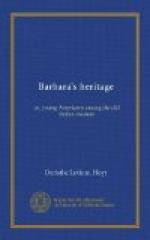The young travellers were just beginning to experience the charm which belongs peculiarly to journeying in Italy—that of finding, one after another, these delightful old cities, each in its own characteristic setting of country, of history, of legend and romance.
They were full of the thrill of expected emotion,—that most delicious of all sensations.
And they received no disappointment from this old “red city.” They saw its beautiful, incomparably beautiful, Cathedral, full of richness of sculpture and color in morning, noon, and evening light; and were never tired of admiring every part of it, from its graffito and mosaic pavement to its vaulted top filled with arches and columns, that reminded them of walking through a forest aisle and looking up through the interlaced branches of trees.
They visited the Cathedral Library, whose walls are covered with those historical paintings by Pinturrichio, the little deaf Umbrian painter, in whose design Raphael is said to have given aid.
But Mr. Sumner wished that the time they could give to the study of paintings be spent particularly among the works of the old Sienese masters. So they went again and again to the Accademia delle Belle Arti and studied those quaint, half-Byzantine works, full of pathetic grace, by Guido da Siena, by Duccio, Simone Martini, Lippo Memmi, and the Lorenzetti brothers.
Here, too, they found paintings by Il Sodoma, a High Renaissance artist, which pleased them more than all else. The Descent into Hades, where is the exquisitely lovely figure of Eve, whose mournful gaze is fixed on her lost son, toward whom the Saviour stoops with pity, drew them again and again to the hall where the worn fresco hangs; and after they had found, secluded in its little cabinet, that fragment which represents Christ Bound to a Column, of which Paul Bourget has written so tenderly, they voted this painter one of the most interesting they had yet found.
To Bettina, the “saint-lover,” as Malcom had dubbed her, the city gained an added interest from having been the home of St. Catherine of Siena, and the others shared in some degree her enthusiasm. They made a pilgrimage to the house of St. Catherine, and all the relics contained therein were genuinely important to them, for, as Betty averred again and again:—
“You know she did live right here in Siena, so it must be true that this is her house and that these things were really hers.”
They admired Palazzo Publico within and without; chiefly from without, for they could never walk from the Cathedral to their hotel without pausing for a time to look down into the picturesque Piazza del Campo where it stands, and admire its lofty walls, so mediaeval in character, with battlemented cornice and ogive windows.
They walked down the narrow streets and then climbed them. They drove all over the city within its brown walls; and outside on the road that skirts them and affords such lovely views of the valley and Tuscan hills. They were sincerely sorry when at last the day came on which they must leave it and continue on their way.




